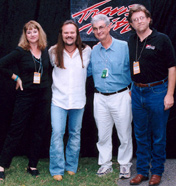|
|
Articles for this Week:
Twice Magic: Famed A.A. Horse Not Out of Barn But Out of Danger
Magic Weisner, the game little Maryland horse that nearly stole the second jewel of racing’s Triple Crown last May, has proved himself twice magic, adding another chapter to his Cinderella story.
This victory was not at the track — though the three-year-old Bay gelding has scored several there in the months since his out-of-nowhere run at the Preakness Stakes won him hearts if not the big money.
This time, death rode the horse Magic beat.
 |
photo by Cristi Pasquella
Racehorse Magic Weisner, who won his race against West Nile Virus. |
On September 2, the eve of owner-trainer Nancy Alberts’ 57th birthday, Magic should have been running the Pennsylvania Derby. The unpromising son of a crooked-legged mare had kept up the speed, reminding track-watchers of another underdog, Seabiscut, who became the most famed athlete of the dreary 1930s.
In the third jewel of the Triple Crown, New York’s Belmont Stakes, Magic had outrun Kentucky Derby and Preakness winner War Emblem, taking a fourth. Magic romped to victory in the Ohio Derby, and in the Haskell Invitational he again raced just behind War Emblem, placing second. Of his 10 other races, he’d won seven.
Alberts was sharing the ride of her life. A trainer too small to reach even the Ma and Pa ranks, Alberts is a one-woman show. Never had a horse earned her much more than its keep. Until Magic, a horse so close to dying at birth that he owes his name to the vet who saved him. In his short career, the three-year-old has brought home nearly a million dollars: $888,110.
Riding high in late August, Alberts had dashed off a note to Bay Weekly. We’re “off to the Pennsylvania Derby,” she wrote.
But on September 2, Magic’s luck turned. Running a 102-degree fever, he was scratched from the race. At the University of Pennsylvania veterinary center, he was diagnosed with inflammation of the brain.
On Alberts’ 57th, her Cinderella horse was “much worse.” His symptoms were consistent with West Nile virus, a mosquito-borne disease that takes birds as its main victims but that also attacks horses and people. West Nile is potentially fatal, and Magic was under heavy treatment with antibiotics and anti-inflammatory drugs.
The disease is on the uprise throughout the nation, and vaccination against it is now available. But it’s still so rare that catching it most likely scored Magic a more dubious first: the first West Nile-infected racehorse in Maryland.
Miraculously, he survived. He’s still shaky, but he’s on the mend. Vets attribute this victory to his youth and athleticism.
And with Magic survived Alberts’ hope. “Today, after I finish training at Laurel, I am going to New Bolton Hospital to pick up Magic,” she told Bay Weekly on September 12. “They say he is not contagious at all and should recover from this completely. Thank heavens!”
— SOM
to the top
Curtain Rises for Symphony, Too
At the Annapolis Symphony Orchestra’s pre-season gala, Music Director Leslie Dunner raised the curtain on the season to come. The orchestra backed a young soloist, violin sensation Hillary Hahn, on challenging concertos by Bach, layered between more palatable pieces by Grieg, Elgar and Turina.
Dunner aimed to increase four things when he was hired: local appreciation for the music of living composers; the Annapolis Symphony Orchestra’s visibility, locally and nationally; the artistic excellence of the orchestra’s music; and the size of the orchestra’s audience.
“I worked on the first three my first four years here,” Dunner says. “Now it’s time to work on the fourth.”
 |
| Leslie Dunner directs the Annapolis Symphony Orchestra. |
He’s not whistling Dixie; the orchestra’s 42nd season won’t be quite as eccentric as the last few, which should appeal to a broader audience. Instead of stumbling over esoteric works from Khachaturian and Corigliano, concert-goers can hum along with familiar tunes from famed composers. But the more conservative program poses a challenge for the orchestra. In past years, it could rest on the breadth of its repertoire; this year it must dig for depth.
The pre-season gala suggested it’s up to the task. Dunner locked eyes with his musicians, who, in turn, played with subtlety and restraint, allowing soloist Hahn to shine.
“We made it a mission this year to highlight young soloists,” says Dunner, before international success skyrockets them out of the reach of so small an orchestra as ours.
That trend continues through the regular season, which opens September 27 with Daniel Lee on Haydn’s elegant Cello Concerto in D Major, again sandwiched between Wagner’s dramatic overture to Rienzi and excerpts from Prokofiev’s dazzling ballet, Romeo and Juliet. The selections show a departure from tradition, as Dunner says the orchestra has played “no Wagner and very little Haydn” since his arrival.
November 22 and 23, Dukas’ delightful La Peri sets the stage for Chopin’s Piano Concerto in E Minor, which comes on like a summer storm, full of thunderclaps and rainbows. The piano is particularly prominent, which is terrific for local virtuoso Brian Ganz. Franck’s Symphony in D Minor provides an appropriate finale, since it flows like a river, meek at first but gathering strength and volume until it washes over the audience.
January’s program is charged with local and national pride. It opens with the orchestra’s own David Perkel on an overture for trombone and strings by adventurous American composer Alan Hovanhess.
“We’re an American orchestra,” Dunner says, “and not to perform the music of America would be a disservice to our country.”
The piece is balanced by two Old World mainstays, however — Mozart’s Horn Concerto No. 3, featuring the orchestra’s Steven Barzai, and Robert Schumann’s romantic Symphony No. 2.
Dunner’s pleased to present opportunities for young orchestra members to shine.
“We are gaining quite a reputation as a high-powered orchestra in this region,” he says.
As a result, Annapolis is losing promising musicians to big-city orchestras like the St. Louis Symphony, which snatched up talented trumpet player Tage Larsen. Dunner doesn’t mind seeing musicians succeed, but he’d like to take advantage of their presence. Along the way, Dunner hopes to break down some of the assumptions people hold about symphonic music.
“There are no taboos,” he says. “No dress code.”
The only requirement is willingness to listen. The reward, Dunner says, is a reminder that “the breadth and scope of the human experience is greater than we think.”
— Brent Seabrook
to the top
City Dock Potties Must Pass Bay Weekly Test, Mayor Decrees
Annapolis, insists Mayor Ellen Moyer, must be the “Best of the Best,” setting an example for others to follow.
But the mayor’s credo was broadsided by Bay Weekly readers, who voted the City Dock restroom the worst public restroom in Chesapeake Country for a second year in a row. Our readers also voted Annapolis the best town, but for Moyer, a best in one category doesn’t make up for a worst in another — even if it is the potty.
Since the Bests were published in our August 22 edition, Moyer has called on all public servants to help Annapolis flush this odorous distinction. She’s asked them to stop in the City Dock restroom, note its cleanliness and supplies of paper towels, toilet paper and soap, then to report their findings.
Is it “Pine Fresh?” asked public information officer Jan Hardesty, relaying the mayor’s directive. “Or would you be inclined to use the petunias on Prince George Street?”
 If the restroom is as bad as Bay Weekly readers say, maybe the public servants should be eligible for hazardous duty pay. Then again, Moyer hasn’t asked the public servants to actually use the restrooms. If the restroom is as bad as Bay Weekly readers say, maybe the public servants should be eligible for hazardous duty pay. Then again, Moyer hasn’t asked the public servants to actually use the restrooms.
Emory Harrison, who supervises the custodial services that clean the restrooms twice a day, has also heard from the mayor. She says the potties are to be brought up to Harrison’s personal standards, passing “The Emory Test.”
Fire Chief Edward Sherlock Jr. followed his mayor’s directive and checked the men’s room out for himself, pronouncing it “very clean.”
Do men and women have different standards of cleanliness?
On a post-mayoral-edict visit to the women’s side of the house September 17, Bay Weekly’s female inspector found the bathroom was cleaner. But the stalls still had smudges and yuck, though the faux mirrors did not. The sickly sweet odor of cleaner couldn’t cover up everything, though it’s better than the other option. Latches on the stall doors were still broken, and
a toilet was stopped up.
It’s still not a place a woman would choose to go because there’s still a feeling of grime on everything, but it isn’t as overwhelming as it was.
The mayor wants the restrooms improved before the Boat Show weekends. We hope she can do it. Of course, there’s a bit of self-interest in our good wishes. Rumor has it that after the restroom meets the Emory Test, she plans to invite Bay Weekly to, well, go there.
— Nancy Hoffman
to the top
Mums the Word Even in Drought
Hilda Chaney’s new for-sale sign advertises her hours as dawn to dusk, but the Lothian flower farmer doesn’t expect to need to work so long.
“I won’t have to worry about that this year,” says Chaney, who made her first sale of the season on September 12, her 79th birthday. Only about 500 of the 1,500 baby chrysanthemums she planted May 6 will be fit for sale.
 |
photo by M.L. Faunce
Since 1989, Hilda Chaney has sold the mums she’s grown on her former tobacco fields. |
Drought is the reason, “the worst I’ve ever seen,” says Chaney. “We got rain on May 10, then not a drop until mid-August.”
Through wet and dry, for 12 years Chaney has planted mums in a little patch hard by the house and fields fronting Route 258 that she and her husband bought in 1960. The daughter of a tobacco farmer in Largo, Chaney became a tobacco wife.
She wasn’t the first in this old tobacco country to plant mums. But in 1989, the last year of their tobacco income, Chaney’s test run of 500 mum plants sold out on the first weekend. After James Chaney died in 1993, the mum crop has paid the property taxes, which have more than doubled over those years.
The mums — which come to Chaney as mere shoots from Ball Seed Co. of Ohio — go in the same way tobacco did. “We set the plants using the old tobacco planter, two of us sitting side by side setting the plants in the machine by hand,” she explains.
Like tobacco, mums take lots of hand work.
Son Jim and daughter-in-law Barbara pitch in on Mother’s Day and the Fourth of July to “pinch the plants back” to encourage growth. “We hit them hard, using scissors to shear and shape the plant to a round mound,” Chaney explains.
This year’s multicolored crop — heavy on customers’ favorites, “yellow, then white and red” — began a quarter smaller than the usual. It’s not just the weather. It’s that Chaney’s “had her eyes done,” and the cataract operation revealed more serious problems that made it difficult to be outside in the sunlight. So she’s slowing down.
“It might be my last year,” Chaney says.
If you come quickly to Hilda Chaney’s mum patch on Route 258, she’ll dig you your choice of mums with her long-handled shovel. “But I won’t tote them this year,” she says. “My customers will have to do that.”
— M.L. Faunce
to the top
Tritt’s Songs Worth Thousands for Calvert Marine Museum
Travis Tritt was not just singing for a huge crowd of cheering fans Labor Day weekend at the Calvert Marine Museum in Solomons. The Grammy Award-winning country singer was singing to bring old boats in out of the rain.
Tritt’s sold-out August 31 performance raised $30,000 toward the expansion of the Small Craft Restoration Center, according to Museum Director Doug Alves.
“We want to expand our maritime history theme and mission,” Alves said of a project long postponed due to lack of funding.
 |
photo courtesy of Calvert Marine Museum
Waterside co-producer Lee Ann Wright, Travis Tritt, Wright’s husband David and Waterside co-producer Michael Jaworek of The Birchmere. |
The Museum’s antique vessel collection is now housed in an open shed, the Small Craft Restoration Center. The expansion, doubling the size of the current building, will allow visitors to view the collection year-round as well as to build their own boats.
Alves’ vision, he said, is for a family to come in on a Saturday morning and, by Sunday afternoon, be finished building and ready to launch its own skiff.
This Labor Day Saturday, 4,500 fans endured a couple hours of misting rain for the sake of hearing Tritt sing — and talk — about “T-r-o-u-b-l-e,” his closing song.
“A great time was enjoyed by all,” said Calvert County Commissioner John Douglas Parran, one of the fans.
With the total take approaching $100,000 before expenses, the concert was the museum’s most financially successful in the 17 years of the Waterside Music Festival. Broadening the 22-year-old museum’s focus on paleontology, sea life and maritime history to include living musical legends, the Memorial Day and Labor Day concerts have brought to Solomons the likes of James Brown, Willie Nelson and B.B. King.
— Sarah Williams
to the top
Way Downstream …
In Chesapeake Bay, the “Code Orange” security level imposed by the government last week has meant the presence of more Coast Guard ships. Associated Press reports that three vessels were patrolling the entrance to the Bay in Virginia: a 270-foot Coast Guard cutter, a smaller Coast Guard patrol boat and a Navy vessel with a law enforcement detachment …
In Maryland, farms and farmland are vanishing more swiftly than in neighboring states and the rest of the country, a study at the University of Maryland reports. The gloomy prognosis is that in the next 10 years, developers will gobble up still another 400 farms and 40,000 acres of farmland …
Our Creature Feature comes from Hong Kong, where eight dogs were honored last week in a campaign to raise awareness of the theraputic effects of dogs and cats. The program, called Animals Asia Dr. Dog, has a 300-dog force, which visits hospitals, orphanages and homes for older citizens.
Among those featured were a police dog who has nabbed 100 criminals, a blind Pekinese named Ocha who is a favorite of sight-impaired children and a two-year-old golden retriever named Jungle who is credited with helping a cancer victim live far beyond the prognosis of doctors.
to the top
Copyright 2002
Bay Weekly
|